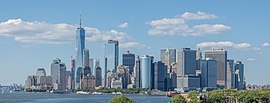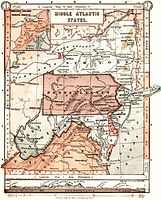
A | B | C | D | E | F | G | H | CH | I | J | K | L | M | N | O | P | Q | R | S | T | U | V | W | X | Y | Z | 0 | 1 | 2 | 3 | 4 | 5 | 6 | 7 | 8 | 9
Mid-Atlantic | |
|---|---|
|
Left to right from top: Lower Manhattan skyline, Independence Hall in Philadelphia, Assateague Island, the skyline of Philadelphia, the Catskills seen from the Hudson River, Downtown Pittsburgh, Downtown Jersey City, and the Washington Monument, Jefferson Memorial, and Washington, D.C. skyline | |
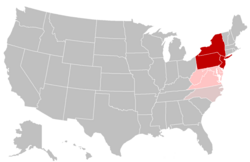 U.S. states in the northern half of the Mid-Atlantic region (highlighted in dark red), states in the southern half of the Mid-Atlantic region (highlighted in pink). North Carolina (which is included occasionally is highlighted in grayish-pink). | |
| Coordinates: 41°N 77°W / 41°N 77°W | |
| Composition | |
| Metropolitan areas | |
| Largest city | New York |
| Area | |
| • Total | 191,299.86 sq mi (495,464.4 km2) |
| • Land | 174,468.45 sq mi (451,871.2 km2) |
| • Water | 16,831.41 sq mi (43,593.2 km2) 8.80% |
| Population | |
| • Total | 60,783,913 |
| • Density | 320/sq mi (120/km2) |
| GDP (nominal) | |
| • Q3 2022 | $5.233 trillion |
The Mid-Atlantic is a region of the United States located in the overlap between the Northeastern and Southeastern states of the United States. Its exact definition differs upon source, but the region typically includes Delaware, the District of Columbia, Maryland, New Jersey, New York, Pennsylvania, Virginia, and West Virginia[3] with other sources including or excluding other states or areas in the Northeast and Southeast.[3][4][5][6][7][8][9] The region has its origin in the Middle Colonies of the 18th century, its states being among the Thirteen Colonies of pre-revolutionary British America. As of the 2020 census, the region had a population of 60,783,913, representing slightly over 18% of the nation's population.
The Mid-Atlantic region played an instrumental and historic role in the nation's founding and the development of the nation. Each of the seven states were members of the Thirteen Colonies that sent delegates to the Second Continental Congress, which assembled in Philadelphia and unanimously adopted the Declaration of Independence, and formalized the Continental Army under George Washington's command during the American Revolutionary War. Following independence, the states again gathered in Philadelphia at the Constitutional Convention, in 1788, where they ratified the United States Constitution, which remains the oldest and longest-standing written and codified national constitution in force in the world.[10]
The Mid-Atlantic region was settled during the colonial era between the early 17th century and the conclusion of the American Revolutionary War in 1783 by European Americans of primarily Dutch, German, Swedish, English, and other Western European ethnicities. Religious pluralism and freedoms existed in the original Thirteen Colonies and were particularly prevalent in Province of Pennsylvania and the geographic region that ultimately broke from Pennsylvania to form the Delaware Colony. Among the 13 colonies, the Province of Maryland was the only colony with a substantial Catholic population.
Following the American Revolutionary War, the Mid-Atlantic region hosted each of the historic capitals of the United States. The nation's capital was constructed in Washington, D.C. in the late 18th century, and relocated there from Philadelphia in 1800.
In the early part of the 19th century, New York and Pennsylvania overtook Virginia as the nation's two most populous states, and the Mid-Atlantic region overtook New England as the most important trading and industrial center in the nation. During this period, large numbers of German, Irish, Italian, Jewish, Polish, and other immigrants arrived in the region's coastal cities, including Baltimore, Newark, New York City, Philadelphia, and interior cities such as Pittsburgh, and Rochester, Albany, and Buffalo, with their skyscrapers and subways, which emerged as icons of modernity and American economic and cultural power in the 20th century.
In the late 19th century, the region played a vital and historic role in the development of American culture, commerce, trade, and industry sectors. Historian Frederick Jackson Turner labeled it "the typically American."[11]
The Northeast Corridor and Interstate 95 in the region link an almost contiguous urban sprawl, which includes large and small cities and their respective suburbs and forms the Northeast megalopolis, one of the world's most important concentrations of finance, media, communications, education, medicine, and technology. The Mid-Atlantic is a relatively affluent region of the nation; nearly half of the nation's 100 highest-income counties based on median household income are located in the Mid-Atlantic, and 33 of the nation's top 100 counties based on per capita income are in the region. Most of the Mid-Atlantic states rank among the 15 highest-income states in the nation by both median household income and per capita income.
The region is home to eight of the top 25 ranked universities in the nation: Cornell University in Ithaca, New York, Columbia University and NYU in New York City, Princeton University in Princeton, New Jersey, the University of Pennsylvania in Philadelphia, Carnegie Mellon University in Pittsburgh, Johns Hopkins University in Baltimore, Georgetown University in Washington, D.C., and the University of Virginia in Charlottesville, Virginia according to U.S. News & World Report Best Colleges Ranking.[12][13][14]
Composition
Definitions of the geographic components of the Mid-Atlantic region differ slightly among sources.[15] Generally speaking, the region is inclusive of the states and federal district of Delaware, the District of Columbia, Maryland, New Jersey, New York, Pennsylvania, Virginia, and West Virginia, with some additional sources including or excluding other areas in parts of the Northeast region and the South Atlantic states, for practical reasons.[3][4][5][6][7][8][9]
The United States Census Bureau defines the Mid-Atlantic as a sub-region of the Northeast and only includes New Jersey, New York, and Pennsylvania.[5] The Bureau of Labor Statistics excludes New York;[3] the Environmental Protection Agency excludes New York and New Jersey;[7] and the U.S. Department of Transportation - United States Maritime Administration includes North Carolina.[8] In 2004, the United States Geological Survey within the context of Ground-Water Vulnerability to Nitrate Contamination, defined the region as including Delaware, Maryland, Pennsylvania, Virginia, and Washington, D.C., and parts of New Jersey, New York, and North Carolina.[6]
West Virginia and Virginia are atypical of this region in a few ways. These states both primarily lie within the Southern American dialect region,[16] and the major religious tradition is largely Evangelical Christian, with 30% in Virginia and 39% in West Virginia identifying as evangelicals.[17] Although a few of West Virginia's eastern panhandle counties are considered part of the Washington metropolitan area, the major portion of the state is rural and there are no major or even large cities.[18]
-
An 1897 map displaying a broad definition of the Mid-Atlantic region
-
An 1886 Harper's School Geography map showing the region, which excludes Virginia and West Virginia
-
The U.S. Census Bureau's geographic definition of the Mid-Atlantic includes three states, New Jersey, New York, and Pennsylvania
History
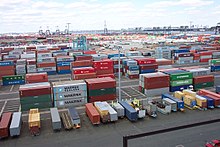
Shipping and trade have been important to the Mid-Atlantic economy since the beginning of the colonial era. The explorer Giovanni da Verrazzano was the first European to see the region in 1524. Henry Hudson later extensively explored that region in 1611 and claimed it for the Dutch, who then created a fur-trading post in Albany in 1614. Jamestown, Virginia was the first permanent English colony in North America, it was established seven years earlier in 1607.
From early colonial times, the Mid-Atlantic region was settled by a wider range of European people than in New England or the South. The Dutch New Netherland settlement along the Hudson River in New York City and New Jersey, and for a time, New Sweden along the Delaware River in Delaware, divided the two great bulwarks of English settlement from each other. The original English settlements in the region notably provided refuge to religious minorities, Maryland to Roman Catholics and Pennsylvania to Quakers and Anabaptist Pennsylvania Dutch. In time, all these settlements fell under English colonial control, but the region continued to be a magnet for people of diverse nationalities.
The area that came to be known as the Middle Colonies served as a strategic bridge between the North and South. The New York and New Jersey campaign during the American Revolutionary War saw more battles than any other theater of the conflict. Philadelphia, midway between the northern and southern colonies, was home to the Continental Congress, the convention of delegates who organized the American Revolution. Philadelphia also was the birthplace of the Declaration of Independence in 1776 and the United States Constitution in 1787, while the United States Bill of Rights was drafted and ratified and the first Supreme Court of the United States sat for the first time, in the first capital under the Constitution of New York.
While early settlers were mostly farmers, traders, and fishermen, the Mid-Atlantic states provided the young United States with heavy industry and served as the "melting pot" of new immigrants from Europe. Cities grew along major ports, shipping routes, and waterways, including New York City and Newark on opposite sides of the Hudson River, Philadelphia on the Delaware River, Allentown on the Lehigh River, and Baltimore on the Chesapeake Bay.
Major states, cities, and urban areas
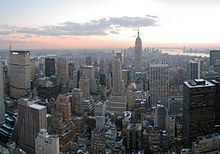



Metropolitan areas
| MSA | 2020 Census | 2010 Census | |
|---|---|---|---|
| 1 | New York-Newark-Jersey City, NY-NJ-PA | 20,140,470 | 18,897,109 |
| 2 | Washington-Arlington-Alexandria, DC-VA-MD-WV | 6,385,162 | 5,649,540 |
| 3 | Philadelphia-Camden-Wilmington, PA-NJ-DE-MD | 6,245,051 | 5,965,343 |
| 4 | Baltimore-Columbia-Towson, MD | 2,844,510 | 2,710,489 |
| 5 | Pittsburgh, PA | 2,370,930 | 2,356,285 |
| 6 | Virginia Beach-Norfolk-Newport News, VA-NC | 1,799,674 | 1,713,954 |
| 7 | Richmond, VA | 1,314,434 | 1,186,501 |
| 8 | Buffalo-Cheektowaga, NY | 1,166,902 | 1,135,509 |
| 9 | Rochester, NY | 1,090,135 | 1,079,671 |
| 10 | Albany-Schenectady-Troy, NY | 899,262 | 870,716 |
| City | 2020 Census | Total area | |
|---|---|---|---|
| 1 | New York, NY | 8,804,190 | 472.43 sq mi |
| 2 | Philadelphia, PA | 1,603,797 | 142.70 sq mi |
| 3 | Washington, D.C. | 689,545 | 68.35 sq mi |
| 4 | Baltimore, MD | 585,708 | 92.05 sq mi |
| 5 | Virginia Beach, VA | 459,470 | 497.50 sq mi |
| 6 | Newark, NJ | 311,549 | 25.88 sq mi |
| 7 | Pittsburgh, PA | 302,971 | 58.35 sq mi |
| 8 | Jersey City, NJ | 292,449 | 21.03 sq mi |
| 9 | Buffalo, NY | 278,349 | 52.48 sq mi |
| 10 | Chesapeake, VA | 249,422 | 350.95 sq mi |
| Township | 2020 Census | |
|---|---|---|
| 1. | Hempstead, NY | 793,409 |
| 2. | Brookhaven, NY | 485,773 |
| 3. | Islip, NY | 339,938 |
| 4. | Oyster Bay, NY | 301,332 |
| 5. | N. Hempstead, NY | 237,639 |
| 6. | Babylon, NY | 218,223 |
| 7 | Huntington, NY | 204,127 |
| 8 | Ramapo, NY | 148,919 |
| 9 | Lakewood Township, NJ | 135,158 |
| 10. | Amherst, NY | 129,595 |
States and federal district
| State or federal district | 2020 Census | Total area | |
|---|---|---|---|
| 1 | New York | 20,201,249 | 54,555 sq mi |
| 2 | Pennsylvania | 13,002,700 | 46,055 sq mi |
| 3 | New Jersey | 9,288,994 | 8,722.58 sq mi |
| 4 | Virginia | 8,631,393 | 42,774.2 sq mi |
| 5 | Maryland | 6,177,224 | 12,407 sq mi |
| 6 | West Virginia | 1,793,716 | 24,230 sq mi |
| 7 | Delaware | 989,948 | 2,489 sq mi |
| 8 | District of Columbia | 689,545 | 68.35 sq mi |
| Census | Pop. | Note | %± |
|---|---|---|---|
| 1790 | 2,085,066 | — | |
| 1800 | 2,702,679 | 29.6% | |
| 1810 | 3,466,545 | 28.3% | |
| 1820 | 4,278,349 | 23.4% | |
| 1830 | 5,362,691 | 25.3% | |
| 1840 | 6,357,873 | 18.6% | |
| 1850 | 8,046,649 | 26.6% | |
| 1860 | 9,929,648 | 23.4% | |
| 1870 | 11,515,592 | 16.0% | |
| 1880 | 13,887,075 | 20.6% | |
| 1890 | 16,566,269 | 19.3% | |
| 1900 | 19,919,159 | 20.2% | |
| 1910 | 24,427,360 | 22.6% | |
| 1920 | 28,144,267 | 15.2% | |
| 1930 | 32,768,581 | 16.4% | |
| 1940 | 34,870,074 | 6.4% | |
| 1950 | 38,951,029 | 11.7% | |
| 1960 | 44,306,759 | 13.7% | |
| 1970 | 48,818,784 | 10.2% | |
| 1980 | 49,532,898 | 1.5% | |
| 1990 | 51,637,657 | 4.2% | |
| 2000 | 55,210,865 | 6.9% | |
| 2010 | 57,999,602 | 5.1% | |
| 2020 | 60,783,913 | 4.8% | |
| Source:1790–2020[21] | |||
State capitals and federal district
| Capital | 2020 Census | Total area | |
|---|---|---|---|
| 1 | Washington, D.C. | 689,545 | 68.35 sq mi |
| 2 | Richmond, Virginia | 226,610 | 62.57 sq mi |
| 3 | Albany, New York | 99,224 | 21.94 sq mi |
| 4 | Trenton, New Jersey | 90,871 | 8.20 sq mi |
| 5 | Harrisburg, Pennsylvania | 50,099 | 11.86 sq mi |
| 6 | Charleston, West Virginia | 48,864 | 32.64 sq mi |
| 7 | Annapolis, Maryland | 40,812 | 8.11 sq mi |
| 8 | Dover, Delaware | 39,403 | 23.97 sq mi |
Note: The Mid-Atlantic region is also home to the nation's capital, Washington, D.C.
In presidential elections
| Parties | |||||||||
| Nonpartisan | Federalist | Democratic-Republican | National Republican | Democratic | Whig | Know Nothing | Republican | Constitutional Union | Progressive |
- Bold denotes election winner.

